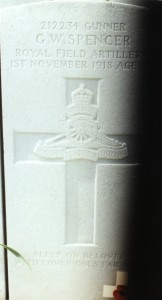Gordon Leonard Stapley
Private 41492
6th Royal Berkshire Regt.
Division 54
 |
Gordon Leonard Stapley was the only son of Mr W J Stapley, of Queen Victoria St. Reading. He had attended Kendrick School, later amalgamated to form Reading School. He is buried in a registered war grave and commemorated on a kerb stone of the family grave. His name also appears on the special memorial in the War Plot. His grave was lost but the author found the grave and after much digging revealed the kerbstones which had sunk below ground level, although nature will doubtless take its course and the grave may be lost again.
Gordon Stapley was very artistic and was by trade a stone mason, he worked for his father who had a business designing and making memorial monuments. His last work was the War Shrine at Knowl Hill Church. Here to the years and nature have taken their toll and lichens have obscured the 197 names of those soldiers, sailors and airman who were killed and are commemorated on the memorial.
Gordon Stapley joined the Berkshire Yeomanry in January 1917 and was later transferred to the 6th Battalion of the Royal Berkshire Regt. He was sent to the front and 24 hours after his arrival was wounded by a shell which landed two yards away from him, causing compound fractures of the right arm. He was sent to Fazakerley Hospital, Liverpool, and appeared to be progressing satisfactorily when pneumonia developed. He died on 31st October 1917, aged 25 years. His was a military funeral.


